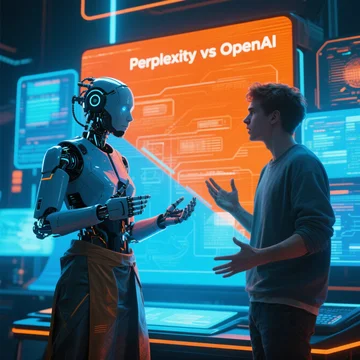In the booming world of artificial intelligence, the debate around Perplexity vs OpenAI is heating up. Both platforms are redefining how we search, chat, and automate work. But which one is right for you? Whether you’re a developer, researcher, or casual user, understanding how these two giants compare in terms of features, pricing, and use cases is crucial before choosing your go-to AI tool.

What Is OpenAI?
Founded in 2015, OpenAI is a pioneer in artificial general intelligence research and the creator of popular tools like ChatGPT, GPT-4o, and DALL·E. Their flagship product, ChatGPT, has become a household name for AI-assisted writing, coding, and data analysis. With a strong focus on safety, alignment, and open collaboration, OpenAI leads in cutting-edge language modeling and creative generation.
What Is Perplexity AI?
Perplexity AI launched in 2022 with a mission to combine conversational AI with search engine functionality. It’s often described as an “answer engine” rather than just a chatbot. Perplexity uses real-time internet access and citation-based search to deliver grounded answers and references, making it a go-to tool for students, researchers, and professionals needing verifiable data instantly.
Key Focus of Perplexity: Search-integrated conversational AI with web citations.
Key Focus of OpenAI: Generative models for text, images, code, and reasoning.
Perplexity vs OpenAI: Key Features Compared
OpenAI (ChatGPT)
Advanced reasoning (GPT-4o)
Image generation (DALL·E)
Code writing/debugging
Plugins & GPT Store
No real-time web access in free tier
Perplexity AI
Web-connected by default
Cited results with links
Focus, Pro, and Copilot modes
Great for fact-based queries
Limited creative generation
Use Case Suitability
When comparing Perplexity vs OpenAI, use case is a critical differentiator. If your goal is to write long-form content, generate code, or build a GPT using a no-code interface, OpenAI is more feature-rich. However, if you need fast factual answers with citations or want an AI that behaves like a search engine, Perplexity is the better choice.
Perplexity vs OpenAI: Pricing and Subscription Models
One of the most asked questions in the Perplexity vs OpenAI debate is about pricing. Here's how their plans stack up:
ChatGPT Free (OpenAI): Access to GPT-3.5
ChatGPT Plus (OpenAI): $20/month for GPT-4o access
Perplexity Free: Basic access with web citations and limited Pro tools
Perplexity Pro: $20/month, includes Claude, GPT-4, real-time Copilot, and advanced focus tools
Interestingly, both platforms price their pro versions at $20/month. However, Perplexity includes models from Anthropic (Claude) and OpenAI (GPT-4) under one subscription, while OpenAI offers access only to its own models.
Real-Time Search: A Big Advantage for Perplexity AI
Unlike OpenAI’s GPT-4o (which can be updated, but doesn’t crawl the web in real time by default), Perplexity AI constantly fetches real-time data from the internet. This makes it ideal for looking up current events, academic papers, news, or anything requiring source-backed accuracy.
Who Should Use Perplexity?
Journalists, students, and fact-checkers will find Perplexity AI incredibly helpful thanks to its citation-first approach. If you’re writing a report or thesis and need sources instantly, this is where it shines.
Who Should Use OpenAI’s ChatGPT?
Developers, marketers, and creative professionals may prefer OpenAI’s ChatGPT, especially with GPTs and the ChatGPT Store. You can generate custom agents, use code interpreters, and produce high-quality images—all within the same interface.
Language Models Behind the Scenes
OpenAI powers ChatGPT with its in-house models like GPT-3.5 and GPT-4o. Meanwhile, Perplexity uses a multi-model backend, integrating OpenAI, Anthropic’s Claude, Mistral, and Meta’s LLaMA. This diversity allows users to switch models on the fly, depending on the task.
“Perplexity feels like Google with AI on steroids. ChatGPT feels like an intelligent coworker that writes and codes with you.”
– Reddit User Review
Model Switching: A Unique Advantage of Perplexity Pro
With Perplexity Pro, users can toggle between models for different needs: GPT-4 for deep reasoning, Claude for summarization, and Mistral for fast lightweight answers. OpenAI, on the other hand, does not currently support model switching within ChatGPT.
Final Thoughts: Which AI Should You Choose?
The Perplexity vs OpenAI debate ultimately comes down to purpose. If you prioritize creative workflows, custom GPTs, or rich plugin ecosystems, OpenAI is unbeatable. But if you need real-time web search, citations, and multi-model flexibility, Perplexity AI is worth the switch.
Key Takeaways
? OpenAI is stronger in creative tasks and enterprise coding tools.
? Perplexity AI excels in real-time fact-based search with citations.
? Both offer $20/month Pro versions—but Perplexity includes multiple models.
? Choose based on your workflow: research vs creation.
Learn more about Perplexity AI
